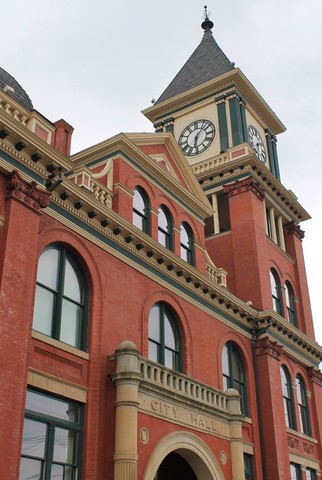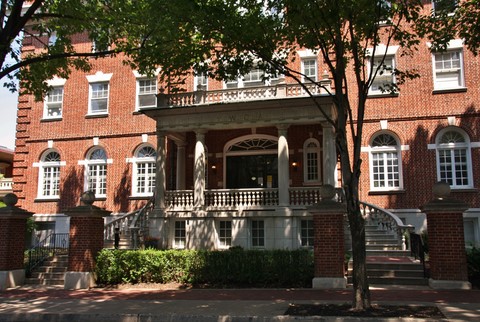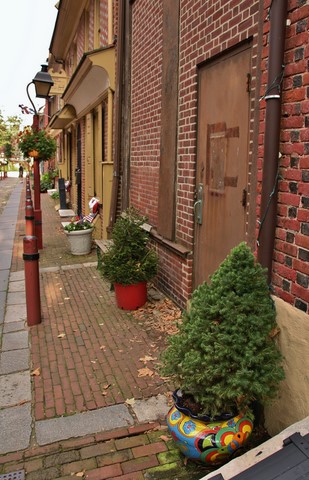Pennsylvania
You can click on pictures to enlarge them
Bradford
We chose to stay in that small town for purely geographical reasons. Indeed, we had to make a night stop between Niagara Falls and Washington. Given that hotels were expensive in the state of New-York and cheaper in Northern Pennsylvania, we opted for Bradford, which is located just under the state border. Like Sonora, California in 2016, it was a revelation, one of the nice surprises of that trip.
So we decided to visit its very charming Historic Center - which dates essentially from the 19th century and the early 20th century - before we go to Washington: though it is small, it enjoys a remarkable architectural wealth. Some façades even display beautiful mascarons. Its superb Old City Hall (photo) in Victorian Romanesque Revival style was built in 1897 with red brick. It was listed on the National Register of Historic Places. It is a four-story building with a tower that houses a four-dialed clock. From now on, it is home to some city government offices. The Hooker-Fulton Building is a nice eight-story Art Deco building that houses among others a theater: Main Street Movie House. The Nice Saint-Bernard’s Catholic Church is surrounded by small lawns and green shrubs that offer a nice contrast with its red bricks and its white statues that stand in the heart of flower beds. The First United Methodist Church, built in 1926-1927 in limestone on the ruins of the old one considered obsolete, was renovated and extended in the late 1950’s. The Old Post Office made of brick displays its beautiful and imposing columns. Built in the early 20th century; its hall includes a nice marble staircase and metal railings. It has also wood and limestone structures. It closed in the 1980’s for the benefit of a bigger and more modern office, but it remains the most impressive buildings in town and it is still the pride of locals.
The Rufus Barrett Stone House is a historic red brick three-story town house. It dates from the early 20th century. It fits the triangular plot of land where it was built, which earned it the name of «Flatiron Building», with reference to the famous building in New-York. Like the Old City Hall, it was listed on the National Register of Historic Places, the same as the Bradford Armory, historic National Guard armory. Nearby stands the Zippo Manufacturing Company, where the famous lighters known all around the world are manufactured. I heard it from a local storekeeper with whom I had a very nice conversation. He taught me many interesting things about his adopted town. I salute him.
Finally, we got on US Route 219, driving along the Allegheny National Forest. We crossed green and wooded landscapes and very typical villages with nice colored wooden houses. Dozens of kilometers away, we came to a fork and turned off, leaving that beautiful state of Pennsylvania to return there some days later. We went to Arlington, Virginia, our stopping-off point to visit Washington DC and its surroundings for three days.
Lancaster
We visited it as we left Arlington to reach New-York. We had planned to make a stop there and another one in Philadelphia.
Lancaster is the oldest inland city in the U.S.A. It is located in the County that bears its name, and that is part of the Pennsylvania Dutch Country: the latter became populated in the 18th and 19th centuries by members of the Amish and Mennonite communities, factions of the Anabaptist movement born in the 16th century in Switzerland, that rejected infant baptism to laud adult baptism. They came essentially from the Netherlands, Germany, Alsace and Switzerland, fleeing religious persecutions. They founded a community that nowadays remains attached to its traditions, focused on family, love for the land and tillage. They refuse violence, technological development and they reject consumer society. Consequently, that excludes motorized means of locomotion and they travel by buggies, those famous horse-drawn carriages. They have no electricity and they use gas lamps for lighting. The only progress they accept is medical advance. Even though many of them are farmers, others work in town. Their handicrafts are high quality and highly prized. Be aware that they do not want their faces to be photographed in any way. So, please be vigilant when you use your cameras.
The German were the first to settle in Lancaster in the early 18th century. It became the county capital in 1729, and even the capital of Pennsylvania from 1799 to 1812, date on which Harrisburg inherited the title. Its architecture and its cultural life are rich and diverse. It has many places of worship, notably the Holy Trinity Lutheran Church, built in red brick and covered with a white wooden roof, the Presbyterian Church, and the Bethel African Methodist Episcopal Church. The Farmer's Southern Market is the oldest market in the U.S.A. It was opened in the 1730’s, and then it became a red brick Victorian style market hall in the late 19th century. Lively, picturesque and authentic, it is listed on the National Register of Historic Places. Excellent farm products are offered, as well as handicrafts, among others those from the Amish community. Besides, we were lucky to meet some of them in the surroundings of the beautiful building.
Philadelphia
It was founded in 1682 by William Penn, English Quaker who escaped from Europe because of religious persecutions. The King of England gave him a territory which later became known as the State of Pennsylvania. He established a society based on peace and tolerance, and maintained friendly relationships centered on mutual trust with Amerindian tribes. He even signed a treaty in that direction. His death some years later contributed a great part to the end of pacifist relationships between settlers and Amerindians.
It is one of the cultural and historic hubs of the country. Museums are numerous, some of them prestigious, and its historic buildings such as Independence Hall and Liberty Bell are absolute must-sees, because they reflect the important role of the city in the American Revolution. It is the cradle of democracy, or even of the American nation in general.
«Philly» has also been the world capital of street-art since 1984, when the Mural Arts Program was initiated in a way that involved the inhabitants of the city, which has more than 3000 of them since then. Some of them are real masterpieces. The basic idea was putting an end to the problems of inconvenient graffiti that polluted the city. Instead of choosing law enforcement, the city’s then Mayor Wilson Goode decided to make the inhabitants in the most affected districts work with established artists, in order to make the walls of the metropolis more attractive with artworks that fit perfectly into the urban landscape. In addition to awareness, they could express their creativity while appropriating their district, or even the city.
We made a three hours stop there, starting with Broad Street, better known as Avenue of the Arts, in front of the Academy of Fine-Arts, which is both a school and a museum. It is a beautiful Victorian Neo-Gothic building with a sumptuous inside decoration that houses prestigious collections. The Masonic Temple is a splendid Neo-Normand building from the 19th century. It is the biggest in the country. It includes seven rooms, each one with a different architectural style. They house collector’s items of Freemasonry. At the corner of Market Street stands majestically the Town Hall, the most beautiful we have ever seen in the U.S.A. during our three trips. In Neo-Renaissance architecture, it is the highest in the country, and the Statue of the founder William Penn on its top is the highest in the world that stands on a building. Its tower offers a panoramic view of the city. After we contemplated its façade, we lingered to admire its interior architecture, very rich and beautiful. We marveled at an elephant head and a buffalo head sculpted above arches. Imposing marble columns, statues, mascarons and other moldings complete the picture.
Then, we walked along Market Street on the left, admiring on the way Market Street National Bank, a superb Art Deco building. In general, magnificent buildings run along that street, notably the one that houses the Hard-Rock Cafe. A splendid vintage electric guitar is fixed on the wall. Before stands a very nice street clock from the 19th century. Unfortunately, we saw the other side of the coin: many homeless were in the streets. Some garbage was on the floor, which is rather unusual in that country according to what we saw during our three trips. That confirms that historical problems of the city scarred by industrial crisis during the 20th century are not buried yet, even though there were significant social improvements in recent years.
However, that did not spoil our visit at all, and we carried on with a light heart reaching Old Town, cradle of Philadelphia, starting with a dip into history as we admired the Independence Hall. Nice Georgian style building, it is less imposing that we ever imagined. Yet, it played an important role in the country’s history: the Declaration of Independence was signed there on the July, 4th 1776. Nevertheless, only a copy is exhibited: the original is in the National Archives. Besides, the United States Constitution was drafted there in 1787. Liberty Bell, great national symbol of liberty, was put up on top of its tower after its arrival from England. It was removed in 1846 because a crack appeared. From now on, it is exhibited in the Independence National Historical Park, nearby.
Then we decided to split into two groups: our friends visited the Independence Hall, whereas J.R. and I carried on with the exploration of Old Town. We first went to Benjamin Franklin Bridge, impressive pale blue suspended bridge that is almost 3 kilometers long and spans the Delaware River to join the city of Camden in the state of New Jersey. We stopped halfway, just to enjoy the panoramic view of both cities (and both states!) and the river, and then we came back to carry on visiting the very typical old town. There we admired many period buildings, notably Corn Exchange National Bank. Then, we met a charming local young woman who walked along with us to guide us in the neighborhood, with that typically American helpfulness. Proud of her origins, she was also proud of her American nationality, and that city where she had always been living in since her arrival on the New Continent from a young age. Yet another short-lived but memorable and enriching encounter like it regularly happens during trips. We gave her a visiting card of our website so that she joins us in it. We salute her… She led us to Elfreth’s Alley (photo), typical and filled with charm, idealized image of Old Town. Built in 1702, it is the oldest residential street in the country. Red brick houses had shutters with various colors while keeping a certain harmony. The Elfreth’s Alley Museum recounts the construction of the street by two blacksmiths - John Gilbert and Arthur West - in order to create a passageway between their workshops and the Delaware River. Visits are available. Bladens Court, a very small adjacent alleyway, is quite charming as well.
Then, it was time for us to leave: New-York was waiting for us. We joined our friends. I went ahead to get back to the car because the three hours for the parking were to expire. On my way, I met a group of ladies and girls, some of them of mixed race, others Afro-American; indeed, that community has a very strong presence in Philly. They asked me to take a picture of them in front of the Academy of Fine-Arts. I accepted gladly but I explained them that I was in a hurry and could not linger. I took various pictures and we had a short conversation. The two girls told me they were from Lyons. They were students there and came to Philadelphia for the summer vacation. What a coincidence! I told them I was French too. Then J.R. also arrived and joined the conversation for a few moments. We gave them a visiting card as well before leaving them. Just like with the young woman in Old Town, we had a good feeling. We really had good vibes during that three hours trip to Philadelphia, which was one of the best moments of our journey.
Published on January, 4th 2019






